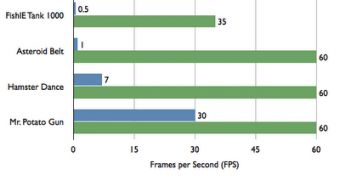Google Chrome is already one of the fastest browsers around. But it can be significantly faster yet, with a little help from the GPU. Hardware acceleration of 2D graphics is now available in the latest Chromium builds and the Canary release, though not enabled by default.
With hardware-accelerated graphics, page rendering, especially for graphics-intensive sites, gets a tremendous boost enabling developers to think bigger when designing a new feature.
"2D canvas acceleration is now available in trunk and the canary build by using the --enable-accelerated-2d-canvas command-line switch (coming to the developer channel shortly). We’ve also been hard at work improving our 3D graphics stack," James Robinson and Gregg Tavares, Software Engineers at Google, announced.
"Chromium’s 2D canvas acceleration uses the same GPU process infrastructure as the compositor, which is designed to maintain the same stability and security Chromium has always had. In addition, this system picks the best graphics API to use on each OS that Chromium supports: Windows XP/Vista/7, Mac OS and Linux," they explained.
The results are more than impressive. In Microsoft's set of hardware acceleration test, which have become the de facto standard, the differences between the Google Chrome 6 stable builds and the latest Chrome 7, with hardware acceleration enabled, are hard to ignore.
In some of the tests, Chrome 7 is 60 times faster and in one case, even 70 times faster. Of course, in real-life the speed-up won't be anywhere near as spectacular as most websites don't really require this kind of hardware power.
But with Chrome 7, Firefox 4 and IE 9 all getting hardware acceleration support, developers can start creating visually impressive websites without fear that it will bring the browser to its knees.
Unfortunately, Firefox 4 only has hardware acceleration in Windows machines and IE9, obviously, is Windows-only, so the only way to get advantage of this on Mac or Linux is with Chrome.
Along with better 2D acceleration, the Chrome team has been working on implementing WebGL, a new 3D graphics standard for the web. They've created a few demos to showcase what WebGL is capable of. The demos only work for Chromium and Chrome 7 Canary users, though the next dev channel release will probably get support for this as well.

 14 DAY TRIAL //
14 DAY TRIAL //